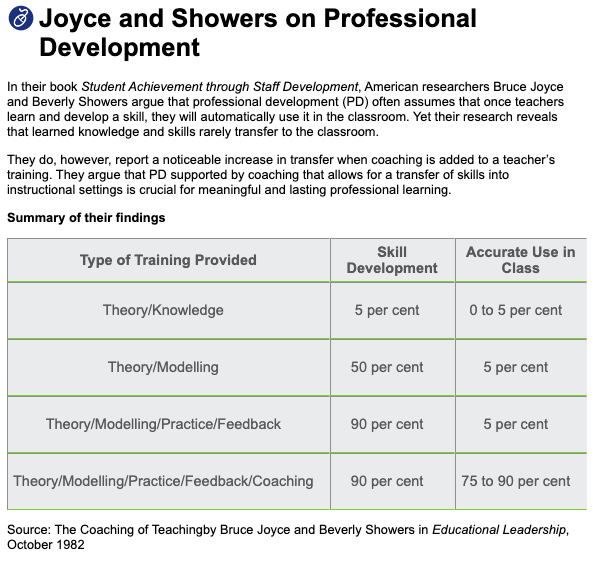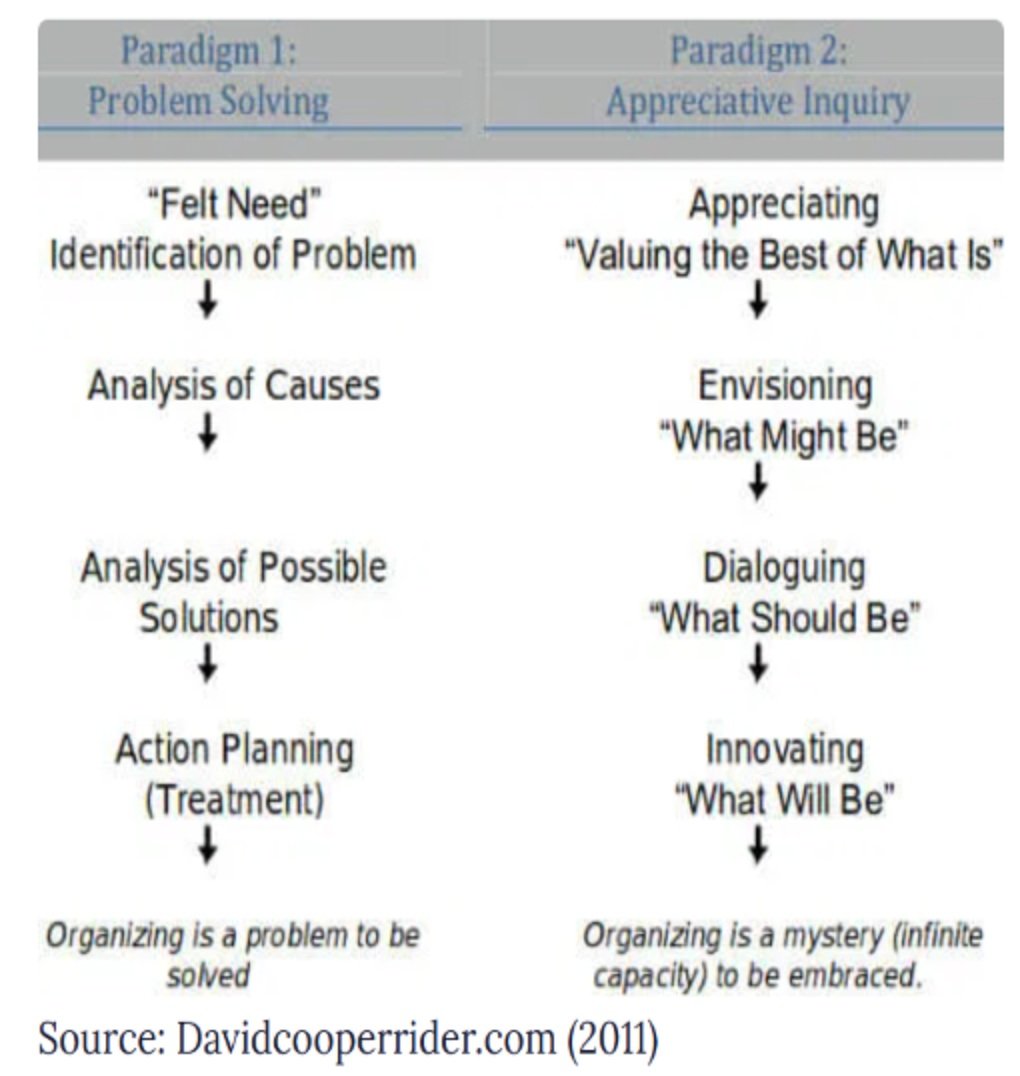Literature review: Coaching and Mentoring Effectiveness
-
Coaching/Mentoring as self awareness:
Angelle (2017) expands on the work of Avolio and Gardener (2005) who purport that self-awareness in leaders leads to decision-making and behaviours that align with values. This notion of self-awareness and subsequent alignment is described as authentic leadership. Angelle’s study employed qualitative research and literature review into authentic leadership as it was practiced by a newly appointed Principal in the USA. The study purports that self-awareness is a key to successful leadership with integrity and since the processes of coaching/mentoring are reflective they can directly contribute to the development of authentic leaders.
Angelle, P. S. (2017). Leading Authentically: A New Principal in Challenging Circumstances. Research in Educational Administration & Leadership, 2(1), 10–27. https://doi.org/10.30828/real/2017.1.2
-
Coaching/Mentoring as support for new leaders:
Watkins' work catalogues the challenges of moving from functional management in an organisation to leading the enterprise. His case study claims that the journey to leadership by an industry manager was propelled by his success in leading discrete functions and specific teams within an organization. Watkins emphasized that the shift to leadership of an entire enterprise demands the development of new skills, understanding new responsibilities and broadening perspectives. In normalising these challenges Watkins promotes coaching/mentoring as an effective way that organizations can support novice leaders.
Watkins, M. D. (2012, June). Career Transitions. How Managers Become Leaders. Retrieved from Harvard Business Review: https://hbr.org/2012/06/how-managers-become-leaders
-
Coaching/mentoring as a way of managing overwhelming work demands:
Kerins and Spaulding (2022) note that the challenges of the novice principal lead to a sense of being overwhelmed by their responsibility for the well-being of all members of their school community and that they are challenged by the volume, diversity and unpredictability of the role. Early career leaders reported having to respond to competing demands from many different stakeholders and, due to the intensity of the work, they struggled to maintain work-life balance.
Sarah K Kerins, & Lucinda Spaulding. (2022). A Phenomenology of the Job-Related Experiences of Early Career Catholic Elementary School Principals. Journal of Catholic Education, 25(1), 84–108.
-
Coaching/Mentoring as development of EQ:
Fernandes’, Wong’s and Noonan’s research is borne out of a study of leadership during the COVID 19 crisis and calls for recognition of the emotional load of school leadership as its invisible labour. This study, undertaken in Victoria, Australia, affirms the complex nature of the roles of school leadership, recommending that support networks be established for school leaders especially during their first five years of principalship. It urges recognition of the emotional workload and action by systems so that early career leaders can develop the skills of agility and resilience. The study has implications for principal preparation programs and provides insight into consideration “on the inclusion of program elements that focus on mentoring and coaching aspirant principals in the first few years of principalship so that specific emotional intelligence skill sets can be developed in them.”
Fernandes, V., Wong, W., & Noonan, M. (2023). Developing adaptability and agility in leadership amidst the COVID-19 crisis: experiences of early-career school principals. International Journal of Educational Management, 37(2), 483–506. https://doi.org/10.1108/IJEM-02-2022-0076
-
Coaching/Mentoring as an antidote to isolation:
This work notes that, in Australia, early career principals’ first appointment is often to a rural and/or remote setting where they experience the combined challenges of the need for high credibility in the community, high levels of visibility, and geographical and professional isolation. Their research confirmed the multifaceted interpersonal dimension of the role comprising complex interactions with a range of groups as well as the dilemmas, tensions and contradictions arising as new leaders balance the realities of their communities with the expectations of their jurisdictions. This research found that because of this emotional burden and isolation, novice principals often had a tenuous hold on their positions as they grappled with these issues. Given that research demonstrates that the principal has a high impact on student achievement they recommend support to contextualise, understand, accept and deal with the emotional demands of the job so that leaders thrive, and school performance is positively affected.
Wildy, H., & Clarke, S. (2008). Principals on L-plates: Rear view mirror reflections. Journal of Educational Administration, 46(6), 727-738. doi: https://doi.org/10.1108/09578230810908316
-
Coaching/mentoring as collaborative learning:
This paper recommends the use of coaching and mentoring as a high impact, collaborative learning experience for staff. It promotes these as means of supporting continuous professional learning and development and to build leadership capability across rural and remote schools to improve “education in the bush”.
Queensland Government: Department of Education. (2021). Working Together: supporting students, staff and leaders in Queensland rural and remote schools. Education Improvement Research Centre State Schools – Rural, Remote and International Spotlight paper March 2021. [Brochure]. https://schoolreviews.education.qld.gov.au/res/Documents/eib-working-together-spotlight-paper.pdf
-
Coaching/Mentoring as mutually beneficial connection:
Affirming the benefits of the mentoring relationship for professional and personal development Birenbaum (2024) describes it as a collaborative relationship between an experienced and less experienced individual - providing re-assurance, career support, skill development and the acknowledgement of achievement. She reports on the development of the mentoring relationship from a one-way, directive relationship to a more reciprocal, mutually beneficial and collaborative connection acknowledging that such a respectfully balanced connection allows both parties to examine situations from different viewpoints. Through open dialogue both parties can gain new insights and perspectives as they discuss real-time issues with which the mentee is grappling. She argues that a successful relationship has the potential to unlock full potential, navigate challenges with confidence, fulfill the compelling human need to belong and nurture a culture of lifelong learning.
Mentoring: Definition, Examples, & Best Practices. (n.d.). The Berkeley Well-Being Institute. https://www.berkeleywellbeing.com/mentoring.html
-
Coaching and Mentoring as 'Just In Time' support:
Lovely (2004) recommends intensive coaching/mentoring processes as the most effective way to support principal induction programs, improve retention and engagement and fast track the transition period. Coaches/mentors can expand the space of possibilities so that the novice can grow in self-awareness to deal optimistically, courageously and creatively with the tension between system expectations and local issues. Citing the University of California Santa Cruz’s New Administrator Program as a lighthouse initiative Lovely (2004) notes that coaches can guide their clients using both instructional and facilitative strategies which move in stance between coaching to mentoring. The program emphasizes flexibility and availability of the coach/mentor to provide both regular and ‘just-in-time’ support.
Lovely, Suzette. Staffing the Principalship: Finding, Coaching, and Mentoring School Leaders, Association for Supervision & Curriculum Development, 2004. ProQuest Ebook Central, https://ebookcentral-proquest-com.theoref.idm.oclc.org/lib/dtl/detail.action?docID=3002086
-
Coaching/Mentoring as development of a growth mindset:
The AITSL Guidelines for the Induction of New School Leaders in Australia 2023 argues that coaching and mentoring play a vital role in leadership training and induction. Mentoring benefits leaders in a practice-focused way by providing the support of a knowledgeable, experienced and effective colleague while coaching is a reflective process in which leaders are guided to take responsibility for their own development, set goals and act. AITSL notes that further outcomes of these processes include the development of tailored learning plans, the development of emotional intelligence, awareness of cultural biases and the development of a growth mind
AITSL. (2023, December). Guidelines for the Induction of New School Leaders in Australia. Retrieved from AITSL Australian Institute for Teaching and School Leadership: https://www.aitsl.edu.au/lead-develop/induction/guidelines-for-the-induction-of-new-school-leaders-in-australia
-
Coaching/mentoring as goal setting and plans to achieve:
Egan’s Skilled Helper model takes a problem-management and opportunity-development approach to helping. This interview with Gerald Egan demonstrates that the Skilled Helper model can assist mentors/coaches to develop strong and supportive relationships with clients as they explore their current situation, imagine possible solutions and set goals and develop action plans to achieve these. Egan explains that he is motivated by a sense of mission to help people deal with and find solutions for the issues they are facing. His framework builds connection and supports personal growth in the context of a safe and supportive emotional environment. While validating the client’s experience the process is open to challenge clients to understand other perspectives as they imagine, plan and work towards a better future. Aligning with the principle of accompaniment, it is a process which is consistent with the values and beliefs of Catholic faith-based organisations.
Wills, F., Egan, G., & Simmons, M. (2004). Gerald Egan in conversation. University of Wales, Newport. http://www.aspresolver.com/aspresolver.asp?CTIV;1666927
-
Coaching/Mentoring as supporting and sustaining change:
Applebaum et al (2012) evaluate Kotter’s model and point to the importance of also recognising cultural change as critical to sustaining change and that some aspects of his steps might not be relevant to this. However, the model remains popular due to the action points being presented in a practical and appealing sequence. While he points to lack of empirical evidence regarding its status, its popularity and success, they assume, is the result of the audience feeling in sync with its content. Finally, they recommend that it may be beneficial to employ components of complementary models to support and sustain change.
Appelbaum, S. H., Habashy, S., Malo, J., & Shafiq, H. (2012). Back to the future: Revisiting Kotter’s 1996 change model. The Journal of Management Development, 31(8), 764-782. doi: https://doi.org/10.1108/02621711211253231
-
Coaching and Mentoring as self determination:
Moore describes the Appreciative Inquiry (AI) Model as a key positive, strength-based change approach to development and collective learning which can engage people in self -determined change by focusing on what’s working, rather than what is not and leads people to co-design their future. The process leads the individual/or group to describe the values, beliefs and capabilities of our organisation when it is working well and what makes up the best of us. In the following diagram, Moore juxtaposes the AI model of change against a deficit model, recommending the latter approach in the mentoring process.
Moore, Catherine. “What Is Appreciative Inquiry? A Brief History & Real-Life Examples.” positivepsychology.com, 27 April 2019. Positivepsychology.com/appreciative inquiry/



